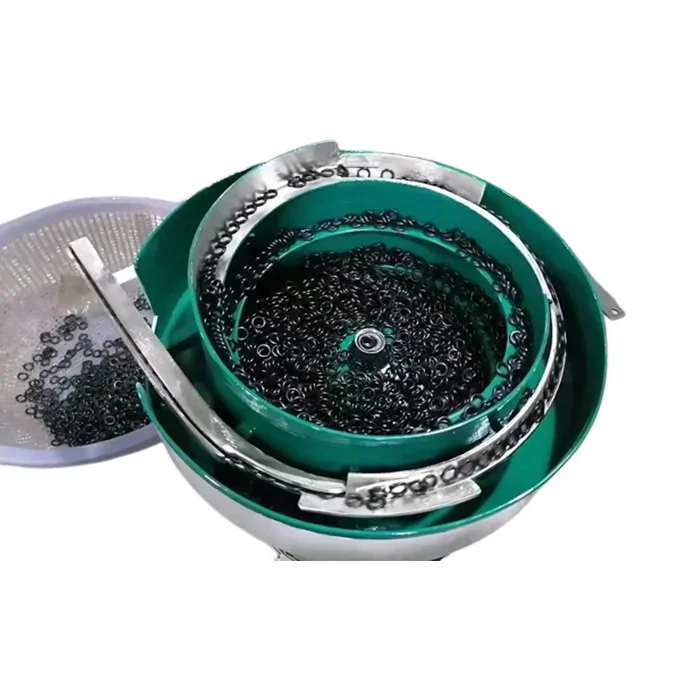Industrial automation has revolutionized the manufacturing industry by increasing efficiency, reducing costs, and improving product quality. One crucial component of industrial automation is the vibratory feeder bowl. Vibratory feeder bowls are used to feed and orient parts in a controlled manner, enabling smooth and efficient assembly processes. In this article, Youde will explore how vibratory feeder bowls improve industrial automation and the various benefits they offer.
What are Vibratory Feeder Bowls

Vibratory feeder bowls are mechanical devices that use vibration to orient and feed parts or components in a controlled manner. These bowls consist of a bowl-shaped container, typically made of stainless steel, and a vibrating drive unit. The drive unit generates vibrations that cause the parts to move along the bowl's track, ultimately aligning them for further processing.
Benefits of Vibratory Feeder Bowls
1. Increased Efficiency
Vibratory feeder bowls significantly enhance the efficiency of industrial automation processes. These bowls are designed to handle a wide range of parts, from small screws to large components, and can feed them at a high rate. By automating the feeding process, manufacturers can eliminate the need for manual labor, reducing the risk of errors and increasing production speed. Vibratory feeder bowls can feed parts at a consistent rate, ensuring a continuous flow of materials to downstream processes, such as assembly lines or packaging machines. This consistent and reliable feeding mechanism improves overall production efficiency.
2. Improved Product Quality
In addition to increasing efficiency, vibratory feeder bowls also contribute to improved product quality. These bowls are equipped with sensors and controls that ensure precise part orientation and positioning. By properly aligning the parts before they enter the assembly process, manufacturers can reduce the risk of misalignment or incorrect assembly. This results in higher-quality finished products with fewer defects. Vibratory feeder bowls can also be customized to handle delicate or fragile parts, preventing damage during the feeding process. By maintaining the integrity of the parts, manufacturers can deliver products that meet or exceed customer expectations.
3. Versatility
Vibratory feeder bowls are highly versatile and can be customized to meet the specific requirements of different industries and applications. They can handle a wide range of part sizes, shapes, and materials. The bowls can be designed with different track configurations, such as spiral, circular, or linear, depending on the specific feeding needs. Additionally, the amplitude and frequency of the vibrations can be adjusted to accommodate different part weights and characteristics. This versatility allows manufacturers to use vibratory feeder bowls in various automation processes, making them a valuable tool in industrial automation.
4. Cost Savings
Implementing vibratory feeder bowls in industrial automation processes can lead to significant cost savings. By automating the feeding process, manufacturers can reduce the need for manual labor, resulting in lower labor costs. Additionally, the consistent and efficient feeding provided by vibratory feeder bowls reduces the risk of production delays or downtime, minimizing the cost associated with idle machinery. Moreover, the improved product quality achieved through precise part orientation and positioning reduces the cost of rework or scrap. Overall, vibratory feeder bowls offer a cost-effective solution for manufacturers looking to enhance their automation processes.
5. Easy Integration
Vibratory feeder bowls are designed for easy integration into existing automation systems. They can be seamlessly integrated with other equipment, such as robots, conveyors, or pick-and-place machines. The bowls can be controlled through programmable logic controllers (PLCs) or other automation control systems, allowing for precise control and synchronization with other processes. This ease of integration ensures a smooth transition to automated feeding, minimizing disruption to existing production lines. Manufacturers can quickly realize the benefits of vibratory feeder bowls without significant reconfiguration or downtime.
Vibratory feeder bowls play a crucial role in improving industrial automation processes. They enhance efficiency by automating the feeding process, increase product quality through precise part orientation, and offer versatility to accommodate various part sizes and shapes. Additionally, vibratory feeder bowls provide cost savings by reducing labor costs, minimizing production delays, and reducing rework or scrap. Their easy integration into existing automation systems makes them a valuable tool for manufacturers looking to enhance their automation processes.
Vibratory feeder bowls are an essential component in driving the success of industrial automation.As technology continues to advance, vibratory feeder bowls will continue to evolve, further optimizing industrial automation processes and driving the industry towards greater productivity and success.
https://www.youdebowl.com/How-Vibratory-Feeder-Bowls-Improve-Industrial-Automation.html
